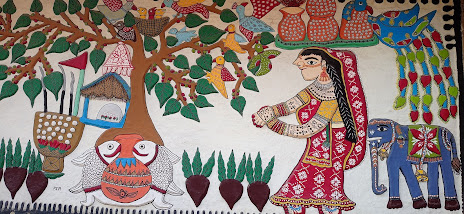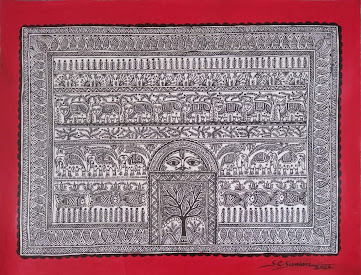A form of tattooing in cultural beauty
By SC Suman
A Fire gave us strength, conversation helped us cooperate, agriculture made us extremely hungry, myth maintained law and order, wealth gave us self-confidence, science made us deadly, and conflict created culture. In a fascinating account of our extraordinary history from simple ape to ruler of the world, author Yuval Noah Harari has written a brief history of the 'sapiens' human race.
Even today, in some communities, there is a belief that people can meet their community in heaven through pictures drawing on the body. Sometimes tattooing is also used medically. If a child is disabled, a tattoo is engraved on a special place on his arm and leg, so that that limb is active. Scholars associate it with the Chinese medical 'acupuncture' method. In some places, there is also a practice of tattooing a skull on the lower part of the navel of a childless woman to open her womb.
Tattooing is an ancient art. The practice of engraving or tattooing has been going on since ancient times, not only here, but all over the world. The literal meaning of tattooing is to repeatedly pierce a surface, that is, to perforate. That is, the art of making skulls on the body with the tip of a needle is called Godana, Godana or tattoo and finger writing art. Once it is engraved, the image remains in the body. Tattooing is very popular among tribal communities. We have different communities living in the districts of East, Central and West Terai in Nepal, especially Tharu, Dunuwar, Satar, Uraau, Rajvanshi etc. This practice is more common in Mithilanchal, especially among women.
There is no definite proof of the origin and development of tattooing. In general, scholars believe that human civilization has its origin and development along with its development. Some scholars are of the opinion that the invention of tattooing occurred suddenly in the same way that the invention of fire occurred suddenly in the forest due to the friction between trees or stones. The use of ash to stop bleeding from a wound caused by a sudden thorn or cut, after the wound has healed, the indelible mark on the body points to its invention.
It is customary to get tattooed both in virginity and after marriage. The tattoo done on a virgin girl is called 'Kumair' tattoo. Tharu society has its own ideas about tattooing. It is also found that there is a tradition of tattooing after the bride goes to her mother-in-law's house for the first time after getting married. It is customary for newly married brides to go home with tattoos on their hands, knees, and neck. The context of tattoo is found to be diverse in each caste community. Somewhere different types of tattoo ornamentation are taken as an identity mark. One person is separated from another person, one ethnic group from another ethnic group and one cultural area from another cultural area. People believe that they will meet their community in heaven through these images. Sometimes tattooing is also used medically. If a child is disabled, a tattoo is engraved on a special place on his arm and leg, so that that limb is active. Scholars associate it with the Chinese medical 'acupuncture' method. In some places, there is also a practice of tattooing a skull on the lower part of the navel of a childless woman to open her womb.
There is also a custom of some men to carve the name of themselves or their lover, their Ishta Devi deity. It is also found that women write their husband's name. In some countries, it is also seen as connected with the courage of a person.There is also an opinion that the more tattoos a woman has on her body, the braver and more fearless she is. However, after suffering so much pain, any brave person dares to get tattooed.
It is a common belief that tattoos are the most important jewelry of women. Tattooing is a cheap and accessible means of beautification for poor women. Some fundamental level plays an important role in the structure of any social life. This Maithili folklore makes it clear that the fact that the whole lifestyle is leading towards a certain direction can be understood from the concept of tattooing, 'Gor Dehme Godna, Kari Dehme Gahana' i.e. white body or Black body tattooing makes sense of the direction of human nature created by humans.
There is also a concept in the context of tattooing that it is a sacred ornament 'which after death, all the ornaments remain in the mortal world, but goes with the tattoo.' After death, nothing goes with it. The tattoo stays with the body only when going to the afterlife. Because of this belief, the place of tattooing is made on that part of the body like jewelry is worn on that part. Over time, due to local conditions and caste beliefs, many beliefs came to be associated with tattooing.
Thus, among these beliefs, one of the beliefs is that ghosts cannot destroy tattoos. It is engraved on different parts of the body like face, neck, chest, hands, arms, thighs, back, legs, claws of hands and feet. In different caste communities, the purpose of the special shape-type tattoo engraved on its separate parts is different. Hence it is also called organ writing. But the tattoo is not engraved on private parts.
'Bundakia' (dots) tattooing is very popular among almost all caste communities, in which groups of dots form a pattern. The word Bundakia refers to a point. There is an abundance of geometrical shapes, square and circular patterns, including armbands on the sleeves, armbands, 'Hansuli' on the neck, temples and 'Garamhars', and ornaments on the hands such as 'Hatshankar'. The figures of sun, moon, scorpion, peacock, elephant, horse, fish, turtle are carved. There is a trend of making such popular symbolic signs in Mithila folk painting.A simple line is carved from a group of dots, which is called 'Sojh Dori', similarly a curved line is made, which is called a 'Lahariya' design. Fruits, leaves, trees, waves and forests are also symbolically made. The portraits of men and women are different. There is a custom to carve pictures of Lord Vishnu, symbols of masculinity such as conch, chakra, mace, Padma, Om, Trishul, Shivlinga ( Lingam) or Hanuman along with Lord Shiva.
The pictures carved in it are carved in a simple and easy way. Which is the initial stage of painting, which can be called the repetition of primitive drawings. This is confirmed by the abundance of geometric shapes such as triangles, quadrilaterals, hexagons, octagons, and circles. In today's modern era, with the help of modern machines, more complex and dense paintings are engraved. As a result, the popularity of tattoos in modern fashion is increasing. Modern tattoos are widely used in different colors and patterns.
For tattooing, three to four needles are tied in a group. After lighting the tuki, the moss is collected in an earthen pot and mixed with water or kerosene in goat's milk to make a thick solution. Somewhere, a special type of black ink (black sesame is thoroughly roasted and prepared into a thick liquid) is used. A group of tied needles are dipped in this solution and the process of slowly inoculating the upper skin of the body is repeated several times.
In order to reduce the pain caused by tattooing, tattooing is usually done in the morning in the cool of the day. After engraving the picture on the jiu, the black ink prepared on the flowing blood is applied, so that the black color goes deep into the skin. After that, a coating of oil and turmeric solution is applied to the tattooed part. There is also a tradition of singing different types of songs to forget the extreme pain of performing this task. These folk songs are popularly known as Godna songs.
Tattooing Tattooing is also done by Muslim women. Which is called 'Nat-Natin'. These are nomadic castes. The men earn their living by hunting and singing 'Allah Rudal', while the women do tattooing. They do not beg. Violence against women increased in the middle ages. Men from elite families, king maharajas used to take away the beautiful daughters-in-law of someone.. In order to avoid their exploitation, tattooing became popular not as a form of beauty enhancement but as an ugly make-up. When they were barred from entering Hindu temples and reciting scriptures as a so-called low caste, tattooing was introduced as a form of social resistance. Therefore, they took Godana as a protest against this ban by writing Ram-Ram, ॐ, ॐ 'Namah Shivaay' on their bodies, making it easier for them to enter the temple, worship and read the scriptures.
The forest-dwelling tribe is called Ram-Nami. This tribe had Lord Ram's name engraved permanently all over their body. It is said that when Babur destroyed the Ram temple, the ancestors of this community said that even if the Ram temple is taken away from us, no one can take away Ram from us and no one can separate Ram from us. Until today this tribe could not convert to any other man-made so-called religion. They tend to be staunch Ram Panthi.
Today, the use of such terminology has become fashionable. Now the same tattoo is being used as a tattoo with modernity.
Photo : SC Suman & Google.















Comments
Post a Comment